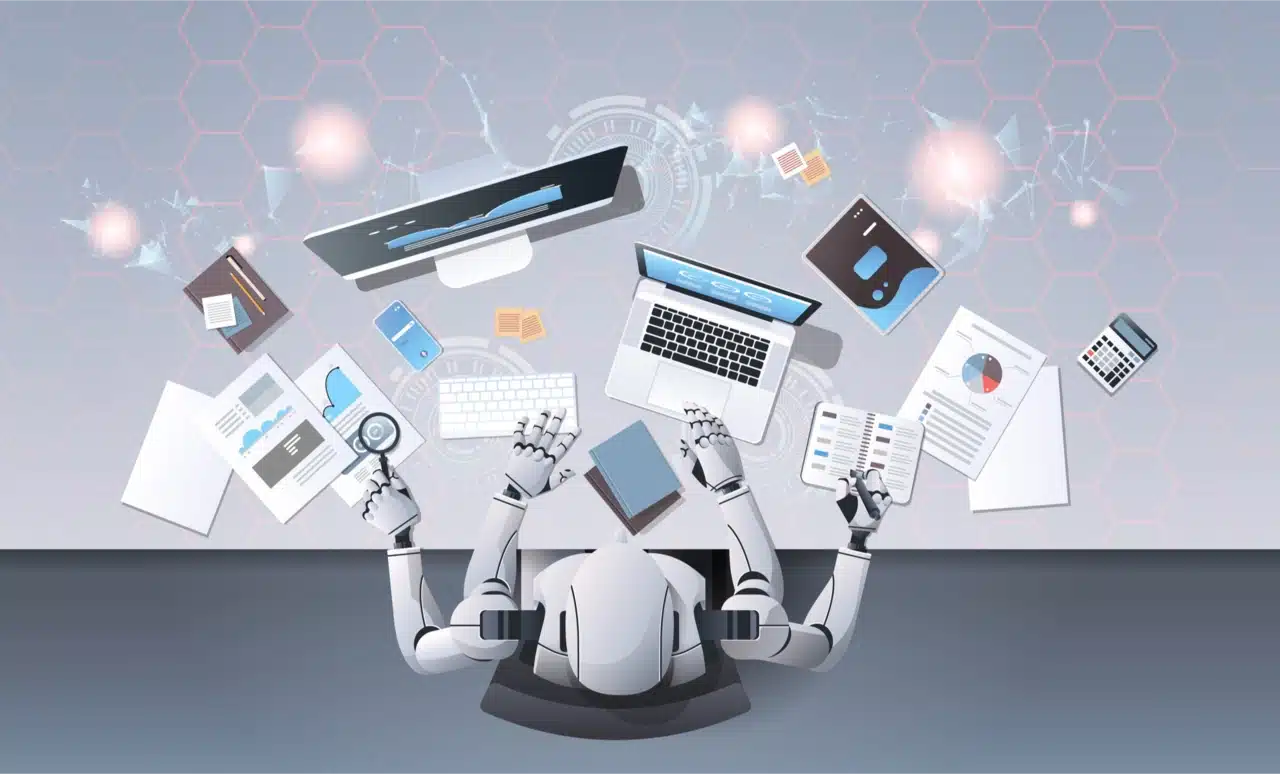Managing Processes with RPA
Reading Time: 6 minutes

Murat Puralıgil
Staff QA Engineer
Robotic Process Automation (RPA) is a technology that automates routine and rule-based business processes using software robots. These robots work without human intervention, accelerating business processes, reducing errors, and allowing resources to focus on more strategic tasks. RPA offers significant benefits to businesses and is applicable in many areas.

Benefits
RPA optimizes business processes to enhance efficiency and savings:
- Error Reduction and Consistency: Minimizes human errors in processes and ensures a standard quality in results.
- Time and Cost Savings: Reduces operational costs with faster processing times.
- Energy Efficiency and Sustainability: Automation lowers manual workload, reducing energy consumption and creating an eco-friendly business model.
- Strategic Human Resource Utilization: Employees can focus on more creative and analytical tasks instead of routine jobs.
Example Processes Where RPA Can Be Applied
Technology Departments
The potential for RPA in these departments is extensive. Some key use cases include:
- Software Installation and Monitoring: Automates software installations and integrates new updates into systems. It can also manage automated testing processes and feedback.
- Testing Processes and Reporting: Manages automated test processes and feedback, as well as generates test reports automatically. This enables faster and more consistent reports by replacing manual operations with RPA.
- Test Data Generation: RPA can be effectively used to automate the creation of test data needed for application testing by QA teams.
- System Integration and Data Synchronization: Automates data synchronization between different systems. For example, it can integrate data between CRM and ERP systems.
- Error Detection and Automatic Repair: Identifies errors in IT systems and produces solutions. For instance, it can follow specific steps to resolve a problem when receiving a specific error message.
- Data Backup and Security Operations: Performs regular data backups and follows security protocols to ensure system safety.
Other Departments
- Customer Service: Automate routine tasks such as answering calls, processing complaints, and organizing customer invoices.
- Sales and Marketing: Optimizes processes like engaging with potential customers, tracking sales opportunities, and managing campaigns.
- Accounting: Speeds up accounting operations such as processing invoices, maintaining financial records, and generating financial reports.
- Risk Management: Assesses customer risks, monitors fraudulent activities, and ensures compliance requirements are met.
Key Differences Between RPA and Test Automation
While both RPA and test automation involve automation, they serve different purposes:
- Purpose:
- RPA: Automates repetitive, rule-based business processes to reduce human intervention.
- Test Automation: Ensures software applications function correctly and without errors.
- Focus:
- RPA: Enhances efficiency and accuracy in business processes.
- Test Automation: Improves software quality and reliability.
- Application Areas:
- RPA: Business processes such as IT, finance, accounting, human resources, and customer service.
- Test Automation: Software development and quality assurance processes.
- Technical Approach:
- RPA: Typically mimics user interface (UI) interactions using low-code or no-code tools.
- Test Automation: Uses test tools and frameworks to create code-based test scenarios.
- Data Usage:
- RPA: Working with live data in a production environment.
- Test Automation: Generally works with test data.
- Working Environment:
- RPA: Operates in a production environment.
- Test Automation: Runs in a development environment.
Suitability of Business Processes for RPA
When automating business processes with RPA, determining suitability is essential. Some critical factors include:
- Repetitive and Structured Processes: RPA is ideal for repetitive and rule-based processes since bots can easily replicate them.
- High-Volume Transactions: RPA efficiently handles processes requiring large data or transaction volumes.
- Low Decision Complexity: RPA is best for tasks with minimal decision-making complexity that follow predefined rules.
- Access to Digital Data: For RPA to function effectively, data must be accessible from electronic files, websites, or databases.
- Standardized Processes: RPA works optimally with standardized processes that follow consistent steps without variation.
These factors form the foundation for assessing process suitability for RPA and developing an effective automation strategy.
AI Technologies in RPA and the Role of Agentic AI
RPA tools enhance bot efficiency and enable them to handle more complex tasks by utilizing artificial intelligence technologies such as machine learning, natural language processing, and image recognition. These technologies expand the capabilities of RPA, shaping the future of automation.
Current AI Technologies in RPA:
- OCR (Optical Character Recognition): Automates data entry by extracting text from documents.
- Natural Language Processing (NLP): Interprets customer requests and generates appropriate responses.
- Machine Learning: Recognizes complex patterns to optimize processes.
Agentic AI Contributions to RPA:
Agentic AI refers to AI systems capable of autonomous decision-making, planning, and executing tasks. This advancement makes RPA smarter and more adaptable. Some key contributions include:
- Autonomous Decision-Making: Enables bots to make complex decisions based on real-time data and context, rather than pre-programmed rules.
- Planning and Execution: Allows bots to plan and execute complex workflows.
- Learning and Adaptation: Enables bots to improve performance through continuous learning.
- Contextual Understanding: Enhances adaptability to changing environments and events, making RPA more dynamic.
- Human Collaboration: Facilitates intelligent systems that collaborate with humans to solve complex challenges.
Agentic AI Shaping the Future of RPA
Agentic AI is transforming the future of automation by making RPA smarter, more flexible, and autonomous. Businesses can automate more complex processes, increase efficiency, reduce costs, and improve the customer experience. This technology has the potential to revolutionize industries such as insurance, logistics, finance, and pharmaceuticals.
Example Scenario: A customer service bot using Agentic AI can analyze customer complaints to determine the most appropriate solution, plan complex workflows, and continuously improve its performance.
Popular RPA Tools
- UiPath: Known for its user-friendly interface, robust AI integrations, and low-code capabilities.
- Automation Anywhere: Commonly used in the finance, insurance, and healthcare sectors due to its analytical features.
- Blue Prism: Ideal for traditional processes, offering strong security features.
Most of these tools offer cloud-based licensing models and cost-effective alternatives for different user needs.
Disadvantages of RPA
Despite its advantages, RPA has some drawbacks:
- High Initial Costs: Licenses, training, and installation can require significant investment.
- Continuous Update Requirements: Regular maintenance and updates are necessary to adapt to changing processes.
- Challenges in Complex Processes: Effectiveness may decrease in highly variable and complex workflows.
- Data Security Concerns: Enhanced security measures are required when handling sensitive data.
- Technology Dependency: Heavy reliance on automation may impact business continuity in case of technical failures.
For individual users and small-scale projects, RPA may be sufficient. However, large enterprises often require enterprise editions or additional features, which come with higher licensing and infrastructure costs.
Key Takeaways
RPA enhances business efficiency by automating processes, reducing errors, and saving time. It provides solutions for businesses of all sizes by streamlining workflows. With AI integration, software robots can handle more complex tasks, making RPA an essential tool for digital transformation.
The future of RPA looks promising, with advancements expected to drive significant changes across industries through broader applications and smarter automation solutions.
Resources
FAQ
RPA, or Robotic Process Automation, is software that configures bots to perform rule-based, repetitive tasks by mimicking human user actions (clicks, data entry, form-filling). It uses structured data and clear decision logic to carry out processes automatically.
Processes with high volume, repeatable steps, standardized rules, and digital data are best suited. Common use cases include invoice processing, payroll, claims handling, and report generation.
- Efficiency & speed: Bots work 24/7 with no downtime
- Accuracy: Near-perfect execution eliminates human error
- Cost savings: Frees up staff from routine tasks
- Scalability: Easily increase automation during peak demand
- Compliance: Bots consistently follow regulations and maintain detailed logs
- Process discovery: Analyze workflows to identify candidates for automation
- Pilot phase: Automate a small, impactful process first
- Development & testing: Adapt bots, test for accuracy, and refine
- Deployment: Roll bots into production with monitoring in place
- Scale & optimize: Continuously assess performance and extend automation to other areas
- Change management: Employees may need training and reassurance
- Process complexity: Unstructured or highly variable tasks require advanced solutions
- Governance: Policies needed around bot access, auditing, and security
- Maintenance: Bots must adapt to changes in applications or workflows
RPA handles structured, rule-based tasks and follows deterministic logic. It isn’t inherently intelligent like AI—but legacy RPA can be enhanced with technologies like OCR, NLP, or Machine Learning in “Intelligent Automation” scenarios.
Reading Time: 6 minutes
Don’t miss out the latestCommencis Thoughts and News.

Murat Puralıgil
Staff QA Engineer



